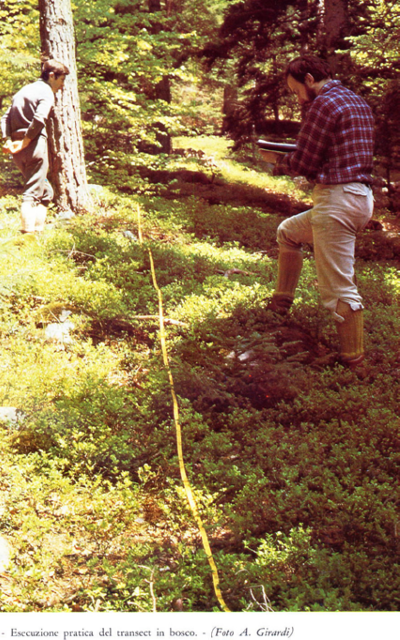Il progetto / The project
I dati di biodiversità di un ecosistema forestale sono fondamentali al fine di caratterizzare qualitativamente un territorio . Lo studio della distribuzione degli organismi viventi ci permette di interpretare e sintetizzare le caratteristiche di un territorio, e rappresenta una delle principali metodologia d'indagine usata in innumerevoli contesti naturali.

In Trentino, nell'ultimo cinquantennio sono state operate molte indagini allo scopo di caratterizzare la ricchezza specifica e la dinamica di vegetazione biodiversità† in ecosistemi forestali. In particolare, a partire dal 1978, la fondazione Edmund Mach ha commissionato uno studio finalizzato a determinare le fasce vegetazionali delle foreste del Trentino secondo la metodologia delle fasce di Schmidt. I dati raccolti, che rappresentano un importantissima risorsa per valutare i cambiamenti e le variazioni della vegetazione in Provincia di Trento, in relazione ai cambiamenti climatici o alle variazioni nellapresenza antropica sul territorio, erano archiviati nelle biblioteche della fondazione, inutilizzati, a causa della modalit√† e del formato con il quale sono stati raccolti.
I dati sono stati quindi recuperati, riorganizzati e salvati un formato aperto (sqlite), accessibile ed interfacciabile con le più moderne tecnologie GIS (Geographic Information System). Inoltre, le mappe originali sono state digitalizzate e georeferenziate, rendendo possibile geolocalizzare i transetti e i punti di campionamento, rendendo possibile quindi, associare un'informazione geografica alle specie rilevate.
Nonostante che la comunità scientifica abbia stabilito l'obsolescenza della metodologia delle fasce vegetazionali di Schmid, i dati floristici conservano ancora un valore informativo importante utile non solo come memoria storica ma anche per moltissime altre applicazioni scientifiche e a supporto della pianificazione territoriale, come la valutazione della introgressione di specie invasive aliene, oppure il controllo della distribuzione delle specie rare o endemiche, o ancora l'analisi dei cambiamenti dell'uso del suolo occorsi negli ultimi 20-30 anni in Provincia di Trento.
The biodiversity data of a forest ecosystem can be applied to provide useful information about a territory. The presence and distribution of living organisms to interpret and synthesize the characteristics of a territory has been used for a long time and in various contexts.
In past years, considerable investigations have been carried out to describe of biodiversity richness and vegetation dynamics in forest ecosystems of Trentino, in particular, the database used for the construction of "Schmid’s vegetational belts", owned by the Fondazione Edmund Mach. The archive had been thought in order to determine the main vegetational belts in the province of Trento and was made along 20 years, since the beginning of the 70s until the early 90s.
This database represents an unique and original historical basis for assessing vegetational changes that occurred over the last 20-40 years, to identify the effects of possible climate change, and to quantify the burden of human impacts on Trentino’s forests.
The database was not structured to be consulted and accessible since developed by obsolete tools and technologies no longer exploitable. A comprehensive process of recovery and database repair has been carried out in the project FORCING. Has been performed an analysis of the data structure, digitizing the latest data, still present paper-based, bringing together and homogenizing 16 districts representing the whole archive, restoring and modernizing the architecture of the original database, eliminating any redundancy. Also, all the maps have been georeferenced, and the related 8,000 detected transect, in order to evaluate the possibility to perform comparative reliefs on update data. At the same time, it has been pursuing the aim of achieving fully accessible both digital data and metadata, to provide the greatest number of project-related information. These data, as well as having important scientific purposes, are useful to safeguard and protect rare vascular species present in the red list, and may represent an important historical reference for comparing the land use cover change through the vegetation information.
Despite the fact that over the years the scientific community has established the obsolescence of the “Schmid’s vegetational belts" system, the floristic data that represent the basis of the raw data of this project still retain an important and irreplaceable information value useful not only as a historical memory, but for many other applications:
- To have a database freely accessible to the scientific community and a Web application accessible to other stakeholders for consultation and information processing.
- Recovering and ordering of the data and the geo-localization of the transects it’s possible to run new survey on the same areas with modern methodologies, using the presence and frequency of over 1300 plant species such as bioindicators, to assess potential impacts due to climate change and/or anthropogenic pressure on forests of Trentino.
- Evaluation of the introgression of invasive and alien species in Trentino.
- Evaluating of care and protection system for species placed in the red list.
- Assess the land use changes in the last twenty years in Trentino.